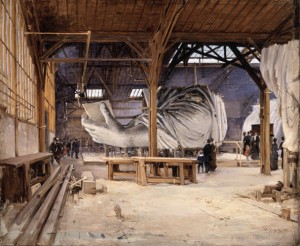Happy Fourth! Have a look at this painting, in the collection of the Santa Barbara Museum of Art:
 The Statue of Liberty in Frederic-Auguste Bartholdi’s Studio, Paris, 1884
The Statue of Liberty in Frederic-Auguste Bartholdi’s Studio, Paris, 1884
Paul Joseph Victor Dargaud’s painting the Statue of Liberty in Frederic-Auguste Bartholdi’s Studio, Paris (1884) commemorates the construction of Bartholdi’s colossus Liberty Enlightening the World better known to Americans as the Statue of Liberty. Dargaud began exhibiting at the Paris salon in 1873, and until his death in 1921 he specialized in topographical scenes of belle epoque Paris. Like Manet and the Impressionists he was fascinated by the city and painted views of Paris that combine a topographer’s eye for realist detail with an impressionist’s sensitivity to the fleeting quality of modern life. A series of his Parisian views are in the Carnavalet Museum in Paris, one of which shows the Statue of Liberty fully assembled outside Bartholdi’s studio.
Inspired on a trip to Egypt by the grandeur of the Pyramids and the Sphinx, Bartholdi imagined a monumental statue of Liberty that would be twice the size of the Sphinx. Liberty was fabricated in Paris at the workshop of Gaget, Gauthier-and Company at 25 rue Chazelles. Work began in 1875. Because of its size the statue was modeled in sections. The right arm bearing the torch was the first portion competed; it was shipped to the United States in 1876 in time for the nation’s centennial. It was not until 1883 that the statue was completed, and on June 15, 1885, the Statue of Liberty-in 214 packing crates–arrived in New York harbor.
A contemporary photograph shows the wooden lattice armature over which a full-scale plaster model of Liberty was formed.’,` Gaget, Gauthier and Company were experts in the art of repousse; a sculptural technique of hammering sheet metal inside molds 11 7 The copper sheets of the statue were hammered onto carved wooden templates. A sturdy intricate internal iron skeleton designed by the celebrated engineer, Alexandre-Gustave Eiffel, supported the statue’s thin copper cladding. Darguad’s view of the workshop represents the stage at which the plaster model for the statue’s left hand and arm had been completed.
 Photo Credit: Courtesy of the Santa Barbara Museum of Art
